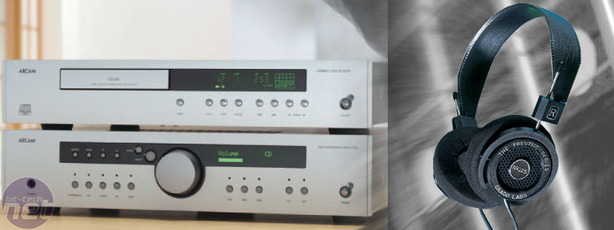
Real World Testing - Gaming
We tested the X-Fi with several games - Doom 3 (with the EAX patch), Battlefield 2, Half-Life 2 and Painkiller. Battlefield 2 is the only game of the bunch to actually support the new features of the X-Fi, allowing the full 128 sound streams, rather than the 64 of the Audigy series of cards. This means more guns, tanks, ambient effects and voice communications at once.Using speakers, all the games sounded great with plenty of punch, clarity and pinpoint spatial positioning. Doom 3 and Battlefield 2 had an eerie sense of really being in the thick of things.


In Battlefield 2, changing the sound settings from “High” to “Ultra High” (only available on X-Fi) produced a frame rate hit of about 5 frames per second. However, we doubled the number of voices being played at once from 64 to 128. The onboard X-RAM did a great job of doubling the audio output, but keeping the frame-rate hit to the bare minimum. However, to be honest we did not consciously notice any differences in the number of sounds being played - we were too immersed in the game, and the differences were incredibly subtle.
We anticipate that games coming out in the future will be making rather better use of the X-Fi-specific features - it rather appears like the features have been 'tacked on' to Battlefield 2. We look forward to seeing what games developers can do with the 64MB of RAM.
All in all, the gaming experience was a good one. Using headphone surround sound and decent pair of headphones, the experience was nothing short of fantastic.
Cinema
It should come as no surprise to find that the X-Fi plays movies superbly, with a dynamic and exciting sound, allowing your surround sound amplifier/speakers to perform to their full potential. The DVD’s Dolby Digital or DTS soundtrack should not require the use of the Crystalizer, since the clarity and dynamics are already at optimum and the Crystalizer can actually make things too piercing. It may be of benefit if you're watching VCD recordings, which can be much lower quality. There's also no need for positional sound enhancement, since the positional data is already present in DD and DTS.

When using 3D sound to enhance stereo movies and DivX files, we found that our results were mixed. There was definitely added immersal and more of a sense of a surround environment, but there was a small added echo to speech, a by-product of the enhancements.
So, the cinematic experience was great when it came to DVDs, as we would expect.
Music
For subjective testing, we used four tracks, each picked for particular qualities such as dynamic, bass control etc. Each track was ripped to a WAV file using Exact Audio Copy in an attempt to produce bit-perfect copies. To assess the sound quality, Grado SR125 headphones were used for critical listening. For comparison, the tracks were also played on a £400 Arcam CD player through a top-end headphone amplifier (JLH Chiara). Tonally, the X-Fi sounded identical to the Arcam, the only noticeable differences being the openness of the soundstage and the clarity of the individual instruments/voices with a slight feeling of compression to the sound. The Arcam/Chiara combination sounded only slightly better than the X-Fi.
We decided to try the soundcard with the Chiara to see if the card was being limited by its headphone amplifier. Connecting the line-out to the Chiara headphone amplifier improved things noticeably. The missing detail and dynamics suddenly appeared, proving that the headphone amp on the card was masking some detail and limiting the X-Fi’s performance. There was no real improvement in the soundstage. This is hardly surprising given the computer environment, which would be considered extremely harsh from an audiophile perspective. One thing that did stand out was the cards silence - there was a total lack of background noise generated by the card. Definitely a good thing.
All in all, the X-Fi was able to perform almost on part with a lot of expensive audiophile equipment, making it a great choice for the more discerning home theatre PC builder.

MSI MPG Velox 100R Chassis Review
October 14 2021 | 15:04








Want to comment? Please log in.